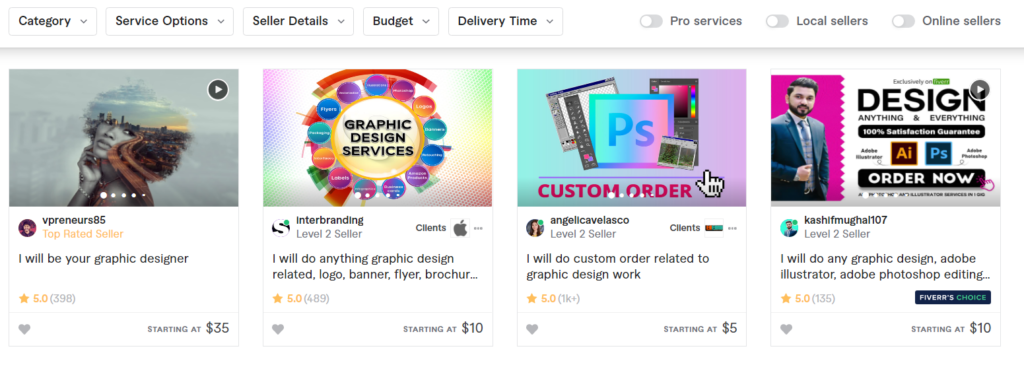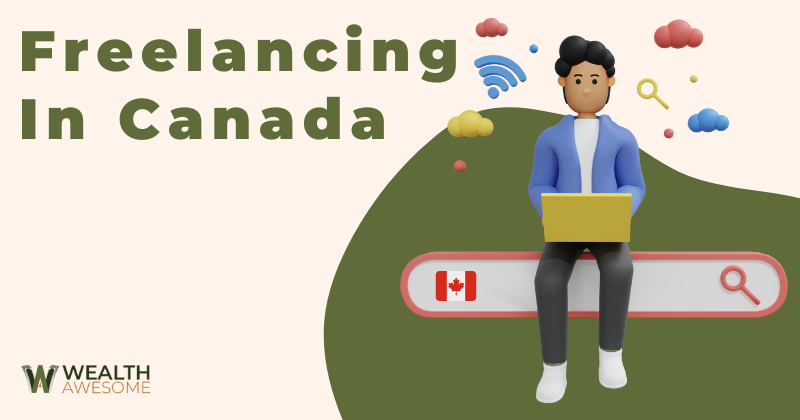Working as a freelancer is one of the best ways to take control of your income and start working for yourself. There’s less risk involved than starting a traditional business, and you get to choose which jobs you want to accept.
Currently, over 15% of Canadians are self-employed as freelancers or sole proprietors.
If you’re ready to start freelancing in Canada, then you’ve come to the right place. Below, I’ll show you everything you need to get started as a freelancer and monetize your valuable skills.
How Can I Start Freelancing As A Beginner?
As a freelancer, your history often precedes you. Depending on the freelance platform you’re using, clients will be able to see your history of completed jobs, client reviews, and more.
So, how can a beginner find freelancing jobs?
- Create a portfolio of work (examples of what you can do)
- Create profiles on online freelancing platforms
- Apply to freelance job listings
- Provide high-quality, efficient work to improve your freelancer ratings
At first, you may have to accept some lower-paying contracts to build up your portfolio. The more good reviews you can earn and the wider your portfolio, the more likely you’ll find higher-paying freelance jobs.
I also recommend having a complete profile with plenty of personal information. The more human you seem to the person on the other side of the screen, the more likely they are to consider hiring you as a freelancer. Let’s go into these steps more in-depth.
How To Start A Freelancing Business In Canada: Step-by-Step

Now, let’s take a look at how to start freelancing in Canada. I promise that it’s a lot easier than it sounds.
Step 1: Create A Portfolio Of Work
First, figure out what type of freelancing services you want to provide. It’s okay to provide multiple services, but I recommend really specializing in one area. This can allow you to earn more money in the future. In the freelancing field, experts generally earn more than the jack of all trades.
To start with, you’ll need to create a portfolio of work. If you don’t have any previous work, then I recommend creating your own example pieces.
For instance, if you’re a graphic designer, you might think of creating mock examples like:
- Logos (3D and 2D)
- Album art or posters
- Photoshop examples
If you’re a writer, you could write short example articles, such as:
- How-to guides
- Sales copy (selling an imaginary or real product/service)
- Email newsletters (attention-grabbing pieces)
Often, when you’re applying for jobs, you’ll be asked to submit examples of previous work. As long as you have a pre-made portfolio, then you’ll be good to go.
One thing I really recommend here is creating a portfolio centred around the type of work you want to do.
For example, if you want to write for travel blogs, have several examples of travel writing in your portfolio that you can submit to travel blog job postings.
Pro Tip: Use Google Drive to manage all of your files and digital portfolio. Google Drive makes it easy to organize all of your files, share them with clients, and gives you 15 GB of free cloud storage so you can access your files no matter what device you’re on.
Step 2: Browse Freelance Job Postings
Now that you have a portfolio, it’s time to start searching for freelancing positions. To increase your chances of landing a good freelancing job, I recommend creating accounts on multiple freelancing platforms.
The Best Sites To Find Freelancing Jobs
Here are some of the best websites to find freelancing work on:
- Upwork (all job types)
- Freelancer (all job types)
- Problogger (writing and proofreading jobs)
- Voices (audio jobs such as narration, translation, etc.)
- Fiverr (all job types)
Once you create your profile, optimize it and fill it out completely. Put yourself in your prospective employer’s shoes here.
What would you want to see if you were paying a complete stranger on the internet to do work for you? What would make the page appear more trustworthy and reliable?
With a complete profile, you’ll want to start browsing freelance job postings.
For example, here are some freelance writing jobs on Upwork:

And, here are some graphic design postings by freelancers on Fiverr:

Step 3: Apply To A Job Posting
Once you find a job that interests you, it’s time to apply. Keep in mind that you’re usually just one of multiple applicants applying to a specific freelance job posting. The more detailed and complete your proposal is, the higher the likelihood that you’ll be considered as a freelancer.
Depending on the platform you’re using, you’ll either need to send a business proposal to the client or fill out an application. During this process, you’ll usually need to provide:
- Examples of previous work
- Cover letter detailing what you bring to the table
- Answers to a few basic questions related to the job
Be sure to check out my tips on how to get more freelance jobs below!
Step 4: Start Work & Finish By The Deadline
Once your proposal has been accepted, you’ll want to complete the assigned work as efficiently as possible. The quicker and more professional you are, the more likely you are to receive a good review or receive future work from the client.
During this process, it’s important to:
- Maintain consistent communication with the client
- Ask the client any time you have a question (never assume)
- Provide feedback and clear examples of what you’re working on
- Keep track of the hours of work you put into the project, so you can use the data for future pricing
What Are The Best Freelance Jobs In Canada?
You can find freelance jobs in a number of different fields. Some of the highest-paid freelancing jobs in Canada include:
- Copywriting (up to $50 per hour)
- Graphic design (up to $80 per hour)
- Virtual assistant/secretary (up to $30 per hour)
- Video editing (up to $50 per hour)
- Audiobook narration (up to $250 per finished hour)
- Product photography/videography (up to $80 per hour)
Tips To Get More Freelance Jobs

Now that you understand the basic process, here are some helpful tips to help you land more freelancing jobs and get more of your proposals accepted.
1. Have A Complete Profile
Remember the people hiring you often live on the other side of the world. Having a profile complete with personal information, work examples, a brief bio, and even a picture of your face, or an intro video explaining your skills helps to bridge the distance and makes you more human.
2. Send Examples Of Previous Work
Even if the client doesn’t specifically ask for previous examples during the application process, I recommend providing them anyway. It shows that you care and will increase the level of trust they have in your abilities.
3. Offer To Talk Via Video Chat
I’d estimate that 90% of freelancers never video chat with their clients before starting work. The mere offer to talk face to face will set you apart from the other freelancers applying for the position.
It shows that you’re confident, serious about your freelancing business, and have no problem answering questions on the spot.
Unfortunately, there are lots of “frauds” out there who rip off clients by exaggerating their abilities in order to land contracts.
Offering to talk face to face through Skype or Zoom is a great way to improve your trustworthiness and improve your chances of selling the client on your services.
Are There Any Downsides To Freelancing?
I started my career off as a freelance writer, and it had a lot of benefits. I enjoyed making my own schedule and having the freedom to travel. However, freelancing also has some downsides, such as:
- Work isn’t always consistent (this is a BIG one)
- Some clients don’t pay on time (or try to stiff you)
- As a freelancer, your employer won’t contribute to a retirement plan
- You’ll need to set aside money to pay taxes as an independent contractor
In my opinion, the benefits of freelancing far outweigh the drawbacks. It’s a good idea to know what you’re getting yourself into, though.
FAQs About Freelancing In Canada
Before we wrap things up, here are a few quick answers to some of the most commonly asked questions I get about freelancing in Canada.
Do Freelancers Need A Business License In Canada?
No. Freelancers are independent contractors who usually work from home. That being said, registering your freelancing business can provide some helpful tax breaks and will encourage you to take your business more seriously.
How Do Freelance Taxes Work In Canada?
As a freelancer, you’ll be taxed as an independent contractor. You’ll be required to collect GST/HST taxes in addition to paying the CRA and your local provincial taxes.
I recommend working with an accountant to figure out how much you need to set aside, so you aren’t caught off-guard when tax season comes around.
How Do I Get Paid As A Freelancer In Canada?
It really depends on how the client wants to pay. Some freelancing platforms hold the money in escrow until the job is complete. Other times, the client will offer to pay through a money-transfer app like PayPal.
Can I Work As A Freelancer In Canada With A Study Permit?
Yes. The great thing about freelancing is that you can work anywhere in the world for anybody. As long as you report your income taxes properly, you shouldn’t run into any issues.
Conclusion

Freelancing offers you a lot of personal freedom and allows you to set competitive rates for skills that you’re already good at. If you’re just starting out, it can be a bit confusing.
By following the steps I outlined above, though, you should be able to land the perfect freelancing job in no time.
How would you like to travel the world while you freelance?
If you want to make the most of your freelance earnings while you travel, be sure to check out my post on how to live an $8,000/month lifestyle on $2,000 next!





